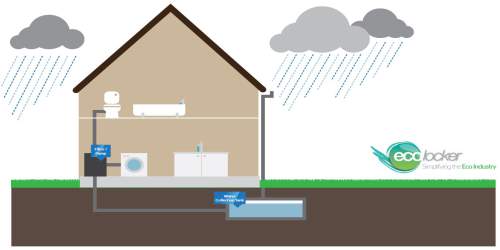Read Time : 3 Minutes
Types of Rainwater Harvesting System
There are a number of different types of rainwater harvesting system that are used in the UK, the cost varying with the complexity and size of the technology being installed. They all have one thing in common which is to utilise our natural rainfall to supplement the mains supply we all take for granted. The major benefit of rainwater harvesting is that it can be done on small and much larger, even industrial scales.
The government has been trying to encourage new builds to include some form of rainwater harvesting system with many commercial premises now incorporating it. Whether it’s on a small scale or larger, the benefits of making the most of the resources we have available has never been more obvious as we face the prospect of climate change. Water harvesting involves relatively simple technology that can be used by both domestic and commercial properties to make a difference.
Water Butts
Probably the simplest form of rainwater harvesting is the water butt that can now be found in many gardens across the UK. They are large plastic containers for collecting water from one drain pipe or through natural rainfall, and are mainly kept for use in the garden to water plants. It will cost you around £50 for a good quality butt that will last a long while and knock something off your metered water bill in the process.
If you have a decent sized garden then a butt can help you reduce your water consumption from the mains. They can also be paired with something like a Rainsaucer, essentially an upside down umbrella that can collect rainwater more efficiently and cleanly than a gutter.
COMPARE PRICES FROM LOCAL INSTALLERS
Compare prices from local companies fast & free
Enter your postcode to compare quotes from leading professionals. We promise to keep your information Safe & Secure. Privacy Policy
Domestic Rainwater Harvesting
If you want to go a step further, and reduce your reliance on the mains, then a more complex rainwater harvesting system can be installed to provide for daily living requirements such as washing clothes and flushing the toilet. There are two main systems you can choose to do this:
Gravity feed systems: These are normally positioned at the top of the building and use the power of gravity to propel the water to different parts of the house. They do not need any other power source such as electricity. Water is collected off the roof when it rains and fed directly into the filter system of the tank.
Pump feed systems: The tank in this instance can be at ground level, or even under the ground, and a pump is then used to distribute the water around the house. You can also opt for a combined pump and gravity system that moves the water to the top of the house to another tank where it can be stored before being distributed through the pipes.
It’s generally accepted that in domestic situations pump feed systems are usually the more efficient because of the small distance that the water has to travel, despite the fact that they need some amount of electricity to run them.
Both systems work the essentially the same way in that they collect water from the roof via the guttering, it passes through a series of filters, and is then stored in a large tank ready for distribution.
There are two reasons for undertaking a project such as installing a rainwater harvesting system and that is to reduce your dependence on the mains supply and help cut down the amount of your water bill if you are on a meter.
Find out more about whether installing rainwater harvesting is worth it here.
Commercial Rainwater Harvesting
The difference for commercial premises that have rainwater harvesting is mainly in the size – the general technology remains the same, if a little more hi-tech. For taller buildings gravity feed systems can often be the more economical option because of the higher water pressure that can be generated.
Rainwater harvesting systems in new builds are becoming far more commonplace with new government guidelines and the requirements of industry bodies such as BREEAM that are trying to ensure businesses become more sustainable. The savings for large scale commercial rainwater harvesting can be quite considerable compared to domestic systems.
The project undertaken for North Chadderton Academy in Oldham has a tank with a capacity for storing up to 50,000 litres and provides a saving on mains water of nearly 3 million litres a year. It can do this because of the large roof space that is utilised to feed into the tank.
Other Rainwater Harvesting Systems
Utilising the excess water from our roofs and gutters is not the only way that rainwater can be collected. One of the latest developments is to use permeable paving to collect water as well as systems that are actually built beneath gardens and that provide a sustainable way of reducing the costs of water bills.
Find a local installer
Welcome to the biggest directory of UK renewable energy companies





 Types of Rainwater Harvesting System
Types of Rainwater Harvesting System


